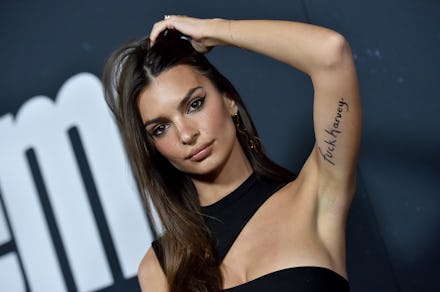Emily Ratajkowski wrote an unflinching essay about the exploitation she's faced in her career

As a young, aspiring model, Emily Ratajkowski says she was assaulted by photographer Jonathan Leder in 2012. In a gut-wrenching and beautifully-written essay for New York Magazine, published Tuesday, Ratajkowski detailed the circumstances of the shoot at Leder’s home — and expounded on the chronic exploitation she’s faced in the modeling industry.
The essay is a fascinating rumination on whether a model owns her own image. The first half of the piece deals mostly with Ratajkowski’s saga with the artist Richard Prince. Two of his “Instagram Paintings” featured Ratajkowski, without her permission, and retailed for $80,000 apiece. She managed to acquire one with an ex-boyfriend, just to exert a modicum of ownership, but when the pair split, Ratajkowski’s ex basically ransomed the art.
She wound up wiring him $10,000 extra to get it back, after she realized he had hundreds of nudes of her saved on his phone. “I exchanged the safety of those hundreds of Emilys for one image — an image that had been taken from my platform and produced as another man’s valuable and important art,” she wrote. This all went down in 2014, by the way, right after the iCloud hack that dumped nude photos of dozens of female celebrities on the internet, including Ratajkowski.
The back half of the model’s essay is about the 2012 shoot in upstate New York with Leder. This was about a year before Robin Thicke’s “Blurred Lines” music video launched Ratajkowski to superstardom, and she was still in the phase of her career where she followed her agent’s marching orders, even if the circumstances seemed sketchy. Ratajkowski makes it clear she was uncomfortable from the moment Leder picked her up at the Woodstock bus station, but she also writes she was eager to prove herself. Even when it became clear Leder expected nude pin-up shots, Ratajkowski felt she could handle it: “I’d been shot nude a handful of times before, always by men. I’d been told by plenty of photographers and agents that my body was one of the things that made me stand out among my peers. My body felt like a superpower,” she wrote.
But at the end of the night, when she was exhausted and drunk (Ratajkowski writes Leder plied her with wine all night, and she was afraid to eat much), the model says she was assaulted by the photographer:
"Most of what came next was a blur except for the feeling. I don’t remember kissing, but I do remember his fingers suddenly being inside of me. Harder and harder and pushing and pushing like no one had touched me before or has touched me since. I could feel the shape of myself and my ridges, and it really, really hurt. I brought my hand instinctively to his wrist and pulled his fingers out of me with force. I didn’t say a word. He stood up abruptly and scurried silently into the darkness up the stairs."
Ratajkowski never confronted Leder or reported the assault. The next morning, she says she got the hell out of dodge as fast as possible. But what happened in the subsequent years is also horrifying: the shoot with Leder was supposed to be for a small artsy magazine called Darius, and a few of the photos Ratajkowski posed for that night were included in its pages. Then years later, Leder published a book full of the previously-unseen nude and semi-clothed photographs. He also staged a gallery show, where the public could gawk at the original polaroids. Ratajkowski fought the book, but her efforts only helped publicize Leder’s project. She never saw a dime from the photos; meanwhile, he released a second book of the polaroids and then a third, siphoning off Ratajkowski's privacy for $80 a pop.
The model's essay is a stark reminder that there's a murky line between exploitation and empowerment — and that no one should be deprived of their personhood in the name of their profession.